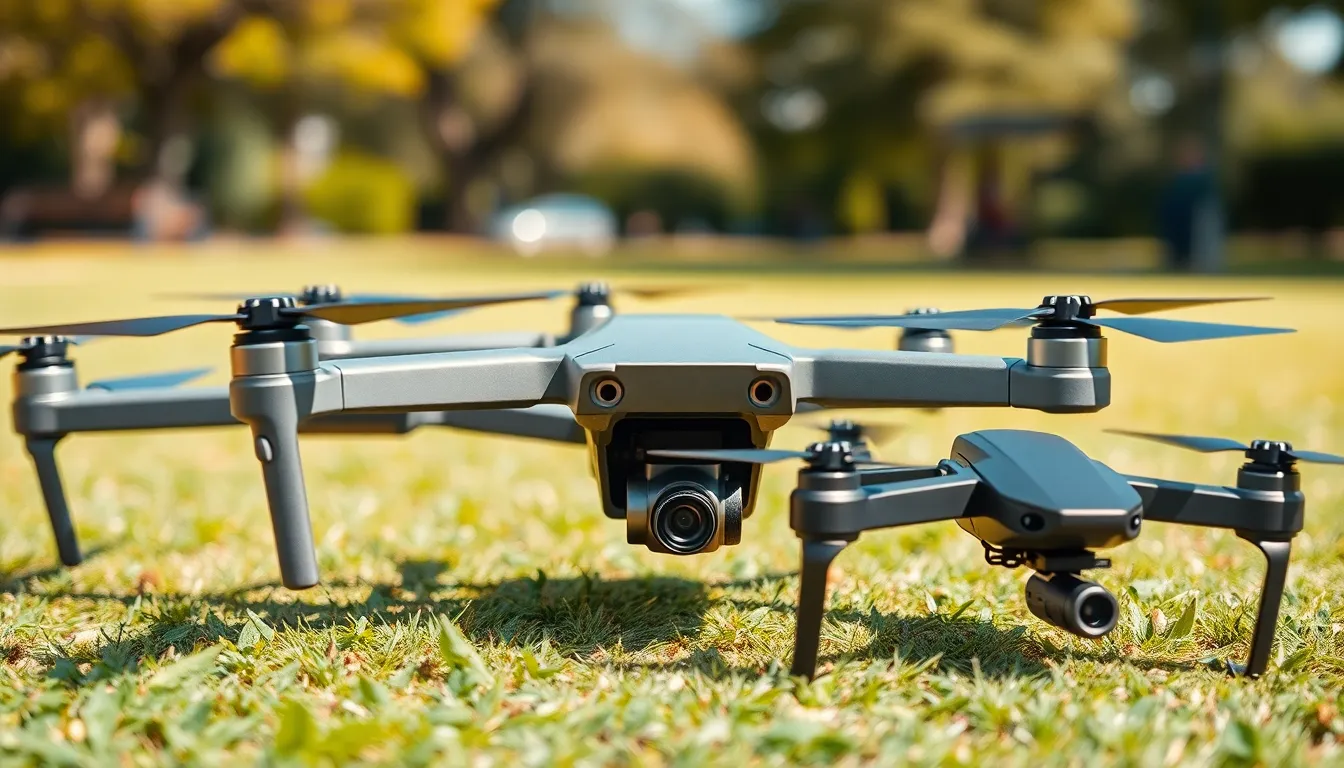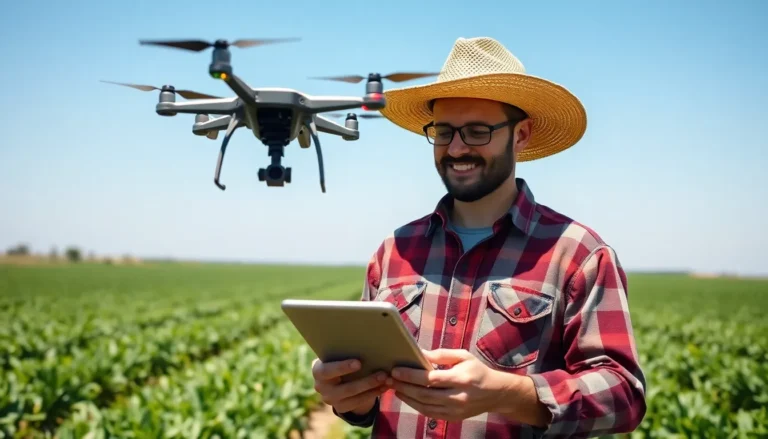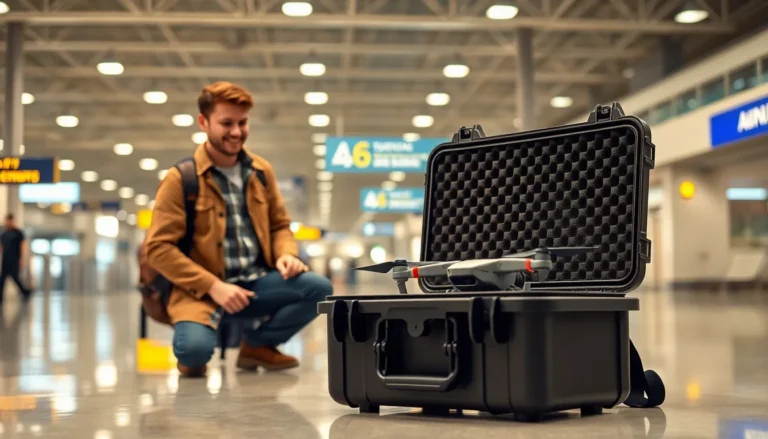Drones have taken the skies by storm, transforming everything from photography to delivery services. With countless models buzzing around, choosing the right one can feel like trying to find a needle in a haystack—if the haystack was also flying. Whether you’re a seasoned pilot or just looking to capture stunning aerial shots of your cat, understanding the differences between drones is crucial.
Table of Contents
ToggleOverview of Drone Comparison
Evaluating different drones involves examining several key features, including camera quality, flight time, range, and ease of use. Camera quality typically varies among models, impacting image resolution and video capabilities. Higher-end drones often offer 4K video recording, while budget options might settle for lower resolutions.
Flight time remains crucial for users who seek extended aerial activities. Most consumer drones provide flight times between 20 to 30 minutes, depending on battery capacity and load. Understanding range is equally important; some drones support distances up to 4 to 5 miles, enhancing their usability for various applications.
Ease of use caters to a broad audience, from beginners to professionals. Features like GPS stabilization and follow-me modes simplify operation for casual photographers. Advanced users can benefit from manual controls, allowing more customization and precise shooting angles.
Budget constraints also factor into the decision-making process. Entry-level drones usually cost around $100 to $500, while high-quality models can exceed $2,000. Comparing warranties and customer support services may provide additional peace of mind during the purchase.
Durability stands vital for outdoor usage; rugged designs often withstand adverse weather and rough landings. The design also influences portability, with foldable options facilitating easier transport.
Understanding these variables empowers users to make informed decisions. Given the diverse applications, whether for professional photography or recreational use, each user can find a suitable drone that meets their specific requirements.
Types of Drones

Drones come in several categories, each tailored to specific uses and audiences. Understanding these types helps in selecting the right model.
Consumer Drones
Consumer drones are widely available in retail environments, designed for hobbyists and casual users. They typically feature user-friendly interfaces and built-in cameras for capturing images and videos. Many models facilitate easy operation with GPS and automated flight modes. Price ranges for consumer drones generally fall between $100 and $2,000, with accessibility being a significant factor for users. These drones often highlight portability, with some models featuring foldable designs for convenience.
Commercial Drones
Commercial drones cater to businesses and professionals across various industries. These models often include advanced technology for applications such as surveying, agriculture, and inspection. Users benefit from higher-quality cameras offering 4K resolution, extended flight times up to 60 minutes, and enhanced durability. Generally, these drones operate under stricter regulations and may require special licenses for use. Prices for commercial drones can surpass $2,000, driven by sophisticated features and functionalities that support professional demands.
Racing Drones
Racing drones focus on speed and agility, appealing to enthusiasts who enjoy competitive flying. Also known as FPV (First Person View) drones, these models provide real-time video feeds to pilots through goggles or screens. Customization plays a key role in racing drones, with parts often upgradeable for faster speeds and improved maneuverability. They typically weigh less, maximizing speed capabilities. Pricing for racing drones usually ranges from $200 to $1,500, depending on components and technology enhancements.
Key Features to Consider
When selecting a drone, several key features play a critical role in making the right choice. Understanding these aspects helps ensure that the chosen drone meets individual needs and expectations.
Camera Quality
Camera quality ranks among the most important features for many users. High-end drones provide 4K video recording, which delivers stunning visuals ideal for professional photography. Some models feature adjustable lenses, allowing for greater versatility. Budget options often offer lower resolutions, which may suffice for casual users. A well-crafted camera setup enhances image stability and captures clear footage, increasing usability and satisfaction.
Battery Life
Battery life is another vital consideration in drone selection. Most consumer drones offer flight times ranging from 20 to 30 minutes per charge. Extended battery life provides users more time to explore and capture breathtaking images. Some advanced models support quick battery swaps, minimizing downtime during flights. Assessing battery performance is crucial, as longer flight times significantly enhance the overall experience.
Range and Control
Range and control capabilities also directly impact drone usability. Many consumer drones operate effectively within a range of 4 to 5 miles, allowing for expansive aerial views. Advanced control options, such as GPS stabilization and automatic return home features, enhance user safety and prevent flyaways. For racing enthusiasts, real-time video feeds and responsive controls create an exciting experience. Evaluating the range helps users determine the drone’s suitability for their intended applications.
Popular Drone Models
Numerous drone models cater to various needs and preferences, making comparisons essential for users. Below are overviews of three popular models.
Model A Overview
Model A excels in features tailored for photography enthusiasts. It offers 4K video recording and a 12-megapixel camera, producing high-quality aerial images. Users appreciate its 30-minute flight time, creating opportunities for extended captures. With a range of up to 4 miles, this model provides versatility for outdoor adventures. GPS stabilization enhances its usability for beginners, while advanced users can leverage manual flight controls. Pricing typically falls between $600 and $800, balancing quality with affordability.
Model B Overview
Model B shines in commercial applications, appealing to professionals in various industries. It incorporates advanced obstacle avoidance technology, ensuring safe operations in complex environments. The integrated 20-megapixel camera delivers impressive clarity for mapping and surveying tasks. Flight times reach 25 minutes, allowing ample time for thorough inspections. Capable of operating at a distance of 3 miles, it supports diverse projects efficiently. Prices for Model B often exceed $2,500, reflecting its specialized capabilities and robust design.
Model C Overview
Model C targets racing drone enthusiasts, focusing on speed and agility. This model boasts rapid response times and customizable settings, enhancing the racing experience. Its HD camera offers live video feeds, crucial for positional awareness during competitions. Users benefit from a lightweight design, achieving impressive maneuvers at high speeds. Flight times average 10 minutes, emphasizing the need for quick battery swaps. Priced between $300 and $700, Model C provides an accessible entry point for hobbyists seeking thrilling aerial challenges.
Performance Evaluation
Evaluating drone performance involves examining several key factors that impact flight quality and user experience.
Flight Stability
Flight stability plays a crucial role in capturing clear images and videos. Many drones incorporate GPS stabilizers and advanced sensors to maintain a steady flight path. Drones equipped with these systems often provide superior performance, especially in windy conditions. Models with multiple rotor configurations, such as quadcopters, generally offer greater stability than smaller, single-rotor designs. A stable flight can significantly enhance the quality of aerial footage, making it essential for photography enthusiasts.
Speed and Maneuverability
Speed and maneuverability are vital for different drone applications. High-performance racing drones boast speed capabilities exceeding 100 miles per hour, appealing to competitive users. Maneuverability often comes from lightweight designs and responsive controls, allowing pilots to navigate through tight spaces effectively. For professionals, commercial drones may prioritize stability and reliability over raw speed, designed for surveying or mapping tasks. A drone’s agility can be critical when avoiding obstacles during flight, ensuring safety and enhancing user confidence.
Choosing the right drone involves careful consideration of various factors tailored to individual needs. With options ranging from consumer to commercial and racing drones, users can find models that fit their specific requirements. Key features such as camera quality flight time and ease of use play vital roles in the selection process.
Understanding the distinctions among different drone types and their capabilities empowers users to make informed decisions. Whether for professional photography recreational flying or racing enthusiasts the right drone can enhance the overall experience. By evaluating personal preferences and budget constraints users can confidently navigate the vast drone market to find the perfect match.





